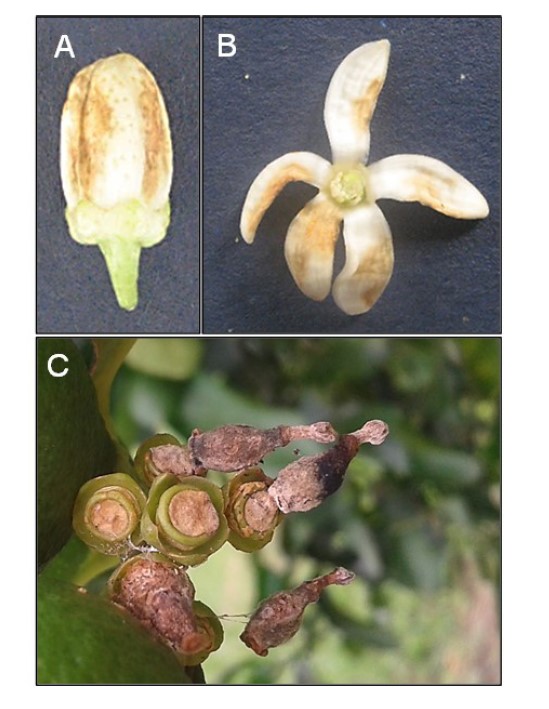Resumen
La antracnosis (Colletotrichum acutatum) reduce considerablemente el rendimiento de los cítricos. Los síntomas de la enfermedad se caracterizan por necrosis de los pétalos, caída prematura de los frutos y formación de cálices persistentes. Con el fin de determinar el efecto del patrón y de condiciones ambientales como la precipitación, la humedad relativa y la temperatura en el desarrollo de la antracnosis, se seleccionaron al azar plantas de lima ácida Tahití injertadas en seis portainjertos: Citrumelo, Sunky x English, Carrizo, Volkameriano, Kryder 15-3 y Cleopatra, establecidos en un huerto experimental en el Centro de Investigación La Libertad de la Corporación Colombiana Agropecuaria AGROSAVIA en Villavicencio, Meta. El experimento se llevó a cabo durante tres estaciones de floración, cada una con condiciones climáticas diferentes. Se evaluó la incidencia de la enfermedad y el porcentaje de cálices persistentes. Los resultados no evidenciaron diferencias significativas en la incidencia de la enfermedad y el número de cálices persistentes entre los patrones evaluados. Sin embargo, el efecto en la caída de los frutos, expresado en cálices persistentes, dependió de las condiciones climáticas que favorecieron el desarrollo del patógeno, siendo los meses lluviosos, la humedad relativa elevada y las temperaturas bajas factores predisponentes de la pérdida considerable de frutos a causa de la enfermedad en la lima ácida Tahití cultivada en el piedemonte llanero de Colombia.
Referencias
Agostini, J. P., Gottwald, T. R., Timmer, L. W. (1993). Temporal and spatial dynamics of postbloom fruit drop of citrus in Florida. Phytopathology. 83: 485-490. https://www.apsnet.org/publications/phytopathology/backissues/Documents/1993Articles/Phyto83n05_485.pdf
Agustí, M., Mesejo, C., Reig, C., Martínez-Fuentes, A. (2014). Citrus production. In Horticulture: Plants for People and Places, volume 1 (p. 159-195). Springer, Dordrecht.
Ciampi, G. M., Baldauf, C., Souza, A. P., Silva, J. G., Amorim, L. (2013). Recent introduction and recombination in Colletotrichum acutatum populations associated with citrus postbloom fruit drop epidemics in São Paulo, Brazil. Phytopathology.104 (7): 769-778. https://apsjournals.apsnet.org/doi/10.1094/PHYTO-06-13-0165-R
De Goes, A., Garrido, R. B., Reis, R. F., Balsassari, R., Soares, M. A. (2008). Evaluation of fungicide applications to sweet orange at different flowering stages for control of postbloom fruit drop caused by Colletotrichum acutatum. Crop protection. 27 (1): 71-76. https://www.sciencedirect.com/science/article/pii/S026121940700107X
Garrett, K. A., Nita, M., de Wolf, E. D., Esker, P. D., Gomez, M. L., Sparks, A. H. (2015). Plant Pathogens as Indicators of Climate Change. En: T.M. Letcher, Climate Change (p. 213-230). Amsterdam, Netherlands: Elsevier. https://www.sciencedirect.com/science/article/pii/B978044463524200021X
Hernández, J., Sharmak, T., Garrett, K. (2014). Climate change and plant Diseases. En: N. K. Van Alfen. Encyclopedia of Agriculture and food Systems (p. 232-243). Amsterdam, Netherlands: Elsevier. https://www.elsevier.com/books/encyclopedia-of-agriculture-and-food-systems/vanalfen/978-0-444-52512-3
Instituto Geográfico Agustín Codazzi- IGAC. (2004). Estudio general de suelos de Suelos y Zonificación de Tierras del Departamento del Meta. Bogotá, Colombia. 538 p.
Kupper, K. C., Correa, F. E., de Azevedo, F. A., da Silva, A. C. (2012). Bacillus subtilis to biological control postbloom fruit drop caused by Colletotrichum acutatum under field conditions. Sicentia Horticulturae. 134: 139-143. https://www.sciencedirect.com/science/article/abs/pii/S0304423811006157
Neto, H. B., Mourão Filho, F. D. A. A., Stuchi, E. S., Espinoza-Núñez, E., Cantuarias-Avilés, T. (2013). The horticultural performance of five ‘Tahiti’ lime selections grafted onto ‘Swingle’ citrumelo under irrigated and non-irrigated conditions. Scientia Horticulturae. 150: 181-186. https://www.sciencedirect.com/science/article/abs/pii/S0304423812004967
Orduz, R. J. & Baquero J. (2003). Aspectos básicos para el cultivo de los cítricos en el Piedemonte Llanero. Achagua. 7: 7-20. https://repository.AGROSAVIA.co/bitstream/handle/20.500.12324/17995/42686_46781.pdf?sequence=1&isAllowed=y
Orduz, R. J., León, G., Arango, W. L. (2009). Lima ácida Tahití: opción agrícola para los Llanos Orientales de Colombia. Villavicencio, Colombia: Corpoica. https://repository.AGROSAVIA.co/bitstream/handle/20.500.12324/12889/44229_56499.pdf?sequence=1&isAllowed=y
Peres, N.A., Mackenzie, S.J., Peever, T.L., Timmer, L.W. (2008). Postbloom fruit drop of citrus and Key lime anthracnose are caused by distinct phylogenetic lineages of Colletotrichum acutatum. Phytopathology. 98 (3): 345-352. https://apsjournals.apsnet.org/doi/pdf/10.1094/PHYTO-98-3-0345
Roose, M.L. (2014). Rootstocks. In: L. FERGUSON, C. E GRAFTON. Citrus production manual. (p. 95-106). Richmond, United States: University of California. Agriculture and Natural Resources. https://anrcatalog.ucanr.edu/Details.aspx?emNo=3539
Sanabria, A., Mahuku, G., Kelemu, S., Cadavid, M., García, C., Hío, J., Martínez, E., Osorio, J. (2010). Molecular identification and characterization of Colletotrichum sp. isolates from Tahiti lime, tamarillo and mango. Agronomía Colombiana. 28 (3): 391-399. http://www.scielo.org.co/scielo.php?script=sci_abstract&pid=S0120-99652010000300005&lng=en&nrm=iso
Silva, J.G., Sposito M.B., Marín D.R., Amorim, L. (2014)a. Efficacy and timing of application of fungicides for control of citrus postbloom fruit drop. Crop Protection. 59: 51-56. https://www.sciencedirect.com/science/article/pii/S0261219414000544
Silva, J. G., Sposito, M. B., Marin, D. R., Ribeiro, J. P., Amorin, L. (2014). Spatiotemporal characterization of citrus postbloom fruit drop in Brazil and its relationship to pathogen dispersal. Plant pathology. 63: 519-529. https://bsppjournals.onlinelibrary.wiley.com/doi/epdf/10.1111/ppa.12138
Soares, C. A., Alvares, C.A., Sentelhas, P. C. (2015). An agro-climatic approach to determine citrus postbloom fruit drop risk in Southern Brazil. International Journal of Biometeorology. 60 (6):891-905. https://www.ncbi.nlm.nih.gov/pubmed/26493198
Timmer, L. W. & Zitko, S. E. (1995). Early season indicators of postbloom fruit drop of citrus and the relationship of disease incidence and fruit production. Plant disease. 79: 1017-1020. https://www.apsnet.org/publications/plantdisease/backissues/Documents/1995Articles/PlantDisease79n10_1017.PDF
Valenciano, J., Giacinti, B. M., Carretero, G.A. (2015). Mapas de competitividad internacional del limón (2002-2010) análisis y comparación del modelo español. Almeira, España: lUniversidad de Almería. 127 p.
Waller, J. (1992). Colletotrichum diseases of perennial and other cash crops. In: J. Balley, and M. Jeger. Colletotrichum: biology, pathology and control (p. 167-185). Wallingford, United Kingdom: CAB International. https://www.cabdirect.org/cabdirect/abstract/19932328417

Esta obra está bajo una licencia internacional Creative Commons Atribución-NoComercial-SinDerivadas 4.0.
Derechos de autor 2021 Revista de la Academia Colombiana de Ciencias Exactas, Físicas y Naturales

